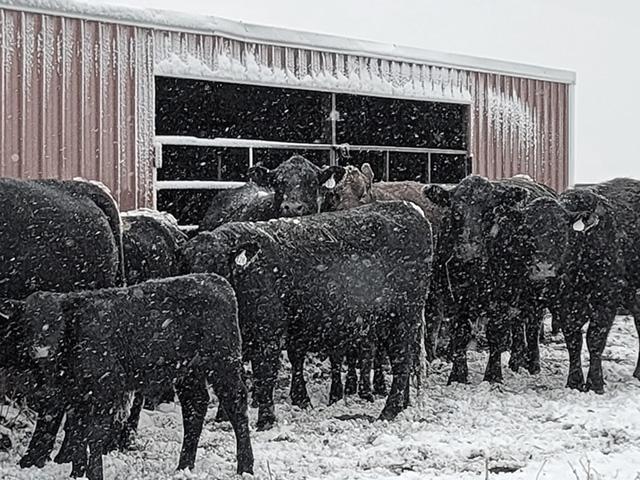Winter Storm to Put Livestock at Risk
Polar Vortex Event Creates Dangerous Conditions for Livestock
OMAHA (DTN) -- As if on cue the week of the winter solstice, a polar vortex event will drop south across most of the U.S. at midweek, bringing with it extreme cold and some snowfall. The front will also bring with it high winds, which could cause blizzard conditions in some locations.
Livestock producers should be prepared for these extreme weather conditions. Producers will need to utilize bedding, shelter or windbreaks for livestock to ride out the winter storm, according to experts.
COLD AIR MOVING SOUTH
A strong arctic high-pressure system will push south, spanning from the Northwest and Great Plains to the central and southern Appalachian region at midweek, according to the National Weather Service (NWS). The front will have subzero temperatures with minimum values nearing minus-20 and minus-30 degrees Fahrenheit moving into the High Plains by Thursday.
"Combined with wind gusts up to 60 miles per hour, widespread wind chill values could drop to around minus-40 degrees through the central and north-central United States," according to the NWS.
DTN Ag Meteorologist John Baranick said temperatures will fall to below zero as far south as northern Texas and Tennessee. Some areas a bit farther south could touch that as well on a day or two, and it will be difficult to get above the freezing mark for a lot of these southern areas as well.
Snowfall isn't expected to have a huge effect from the storm this week. While eastern Nebraska and Kansas up through the Great Lakes could see several inches, anything over a foot would likely be confined to lake-effect-prone areas east of each of the Great Lakes, Baranick said.
Baranick said what will be more important later this week will be the high winds and the extreme cold.
"Many areas across the Plains and behind the cold front will see winds gusting in the 45- to 55-mph range, and some areas could see gusts higher than that, particularly in the eastern Midwest," Baranick said.
P[L1] D[0x0] M[300x250] OOP[F] ADUNIT[] T[]
While the blast of arctic air will be intense, the good news is that it will not last for very long, he said. Warmer weather will be building up across the West by the end week, and perhaps on Christmas Day, low temperatures will stay north of zero for all but the Upper Midwest.
Temperatures will rise from there into next week, although it may be hard to accomplish this with the widespread snow coming from this week's blizzard, Baranick said. Deep snow cover already is present across the Northern Plains from last week's blizzard.
LIVESTOCK PRODUCERS: PLAN FOR COLD
Livestock producers in these areas with extremely cold temperatures need to consider cold weather practices to protect their animals. Colorado State University (CSU) Extension has an extensive list of severe cold weather considerations (https://extension.colostate.edu/…).
The CSU report suggested moving livestock before or at the onset of extreme winter weather. For short durations, landscape topographic features such as ravines, canyons, draws and natural windbreaks may be sufficient protection from the elements.
Cold temperatures without wind are usually not enough to affect the performance of animals. Wind alone can cause the same effect on animals as exposure to a sudden drop in temperature. A 20-mile-per-hour wind is roughly equivalent to a 30-degree drop in temperature.
Livestock producers should utilize shelter, sheds or windbreaks during cold temperatures.
Windbreaks that are taller and denser (have fewer openings) are more effective than other types of windbreaks. Windbreaks can be manmade or natural, generally trees.
In cold conditions, cattle should have abundant and accessible feed, which will help them maintain their body temperature and survive the cold. Livestock will need extra feed in severe cold weather to maintain body temperature and body condition.
WATCH BULLS TOO
The management of bulls is a critical component of winter livestock management considering they contribute half the genetics to a cowherd. DTN wrote about this subject at the end of 2020: https://www.dtnpf.com/….
Research has shown bulls generally lose anywhere from 100 to 400 pounds during the breeding season, or about 10% to 15% of their body weight. They need to regain the weight before the next breeding season, and for most producers, the time to put some weight back on bulls would be during the winter months.
Cold weather can have negative effects on the fertility of bulls. Cold weather and windchill can result in bull infertility with tissue damage to the scrotum.
Frostbite lowers semen quality in bulls, according to studies. The soundness score of semen quality of bulls with frostbite can drop significantly.
Producers should utilize breeding soundness exams with their bulls. There are four components of the exam: a general physical exam, a scrotal circumference measurement, sperm motility and sperm morphology.
This breeding soundness exam should be done four to six weeks prior to the breeding season.
Russ Quinn can be reached at Russ.Quinn@dtn.com
Follow him on Twitter @RussQuinnDTN
(c) Copyright 2022 DTN, LLC. All rights reserved.



